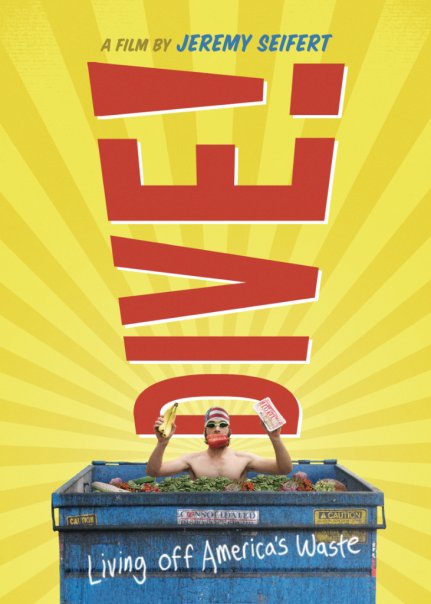The dumpster-diving documentary Dive! is part of a slew of books and exposés highlighting a disturbing fact: North Americans waste a staggering amount of food. But what about us in the Pacific Northwest? Are we any different?
Tristam Stuart puts it in perspective in Waste, “There are nearly one billion malnourished people in the world, but the approximately 40 million tons (80 billion pounds) of food wasted by US households, retailers and food services each year would be enough to satisfy the hunger of every one of them.” The US Environmental Protection Agency says food waste accounts for almost 14 percent of the total municipal solid waste stream in the United States. All that rotting food produces methane gas, which is 21 times as potent a greenhouse gas as carbon dioxide, molecule for molecule.
Dive! focuses on greater Los Angeles. The LA Food Bank, the film calculates, is short 11 million pounds every year, even while the groceries, restaurants, and households in LA County—according to Dive!’s calculations—throw away 2.9 billion pounds of food annually.
Is Cascadia like Los Angeles? Do we squander nutrients on a similar scale? Do local food banks constantly struggle to meet neighborhood needs?
Unfortunately, a quantitative, side-by-side comparison of Cascadia and SoCal is not possible. Still, if you believe those whose job it is to recover groceries for hungry families, such as food pantry leaders, you’d be pleased to learn that Cascadia is no wastrel of calories.
Nancy McKinney directs the Ballard Food Bank in Seattle. “We have volunteers that glean from all major local stores in the area, and several minor ones as well,” she says. “Seventy percent of our food comes from gleaning, diverting ‘old’ food in grocery stores from the waste bin, thirty percent from distributors.” By “distributors,” she means nonprofit organizations such as Food Lifeline and Northwest Harvest.
The Ballard Food Bank’s gleaning program works with all major grocery stores in the area and several small ones. Is it enough? The Ballard Food Bank serves around 1,200 people a week. “We could serve more,” says McKinney, “but the biggest barrier I think is in the individuals. It’s a question of pride. People don’t want to get food from a food bank.”
Amythst Shipman, grocery rescue manager at FoodLifeline, works with retailers and agencies across western Washington to gather food from grocers and distribute it to those in need. “I can’t say what percentage of discarded food we capture, but we do ask for as much as we can.”
She saw Dive! but doesn’t think the pattern of waste in southern California applies to the Pacific Northwest.
“We have a really amazing relationship with the retailers that we work with; 200 stores and 100 partnering agencies. What happened in Dive! has not been my experience. The retailers are very cooperative.”
The Oregon Department of Environmental Quality’s 2050 Materials Management Vision is a model in addressing food waste. It reports that full-service restaurants in the state dispose of roughly 80 million pounds of food per year, 40 percent of the overall disposed food from the business sector. Grocery stores dispose of another 42 million pounds per year.
Oregon’s gleaning is as thoroughgoing as Washington’s. Mike Moran of the Oregon Food Bank, says, “We’re held up nationally as an example.” The Fresh Alliance, an 11-year-old nonprofit, recovers aging but still-edible food from 200 grocery stores five days a week.
One area of continuing waste? Moran speculates about dented cans. “They have to be thrown away due to food safety regulations. If there’s a crease in the can, there’s a possibility the lining is broke, which could lead to contamination.”
Moran estimates that dents force OFB to discard 10 to 15 percent of the cans it gets. He speculates that wholesalers, distributors, and retailers toss many more cans long before they reach OFB.
According to those whose institutions dumpster-dive for the hungry, the lessons of Dive! do not apply in metropolitan Oregon and Washington. What about elsewhere in Cascadia? Share your experiences in comments!
“While focusing on food waste is a good thing, it’s only part of the solution,” says one source at the Environmental Protection Agency. “The untouched issue is household food waste. Nationally, household food waste is about equal to restaurant and grocer food-waste combined.”
To address household waste, the EPA is working on a number of programs, such as the Sustainable Food Management Initiatives and the Food Recovery Challenge. It is also partnering with Green Sports Alliance and Rock and Wrap it Up to address waste at sports events and rock concerts.
These aren’t hard data, but the consensus of Cascadia food gleaners is that we do much better than the LA depicted in Dive! Still, we have plenty of opportunities to slash food waste, saving ourselves money and natural resources along the way—and sparing the climate some extra-potent emissions. Our own kitchens may be the best places to start.
Chris LaRoche guestimates that 50 percent of his weekly meals by weight come from the nearby dumpster of an artisan bakery.


Comments are closed.